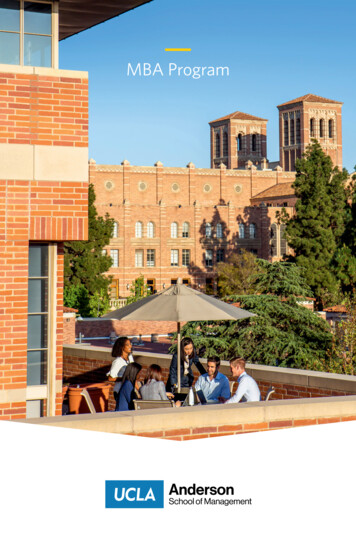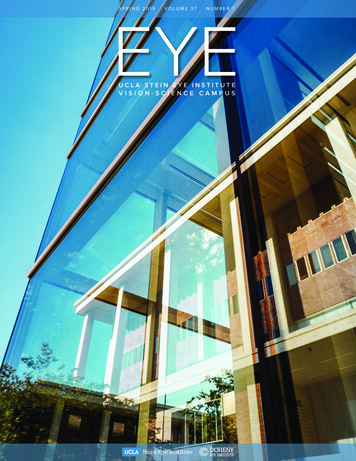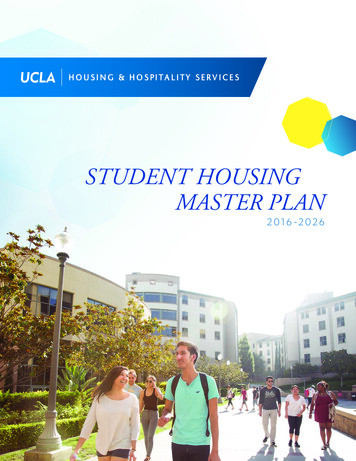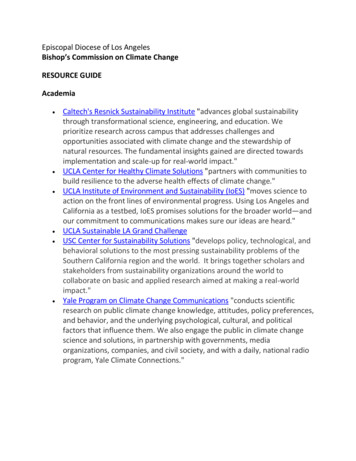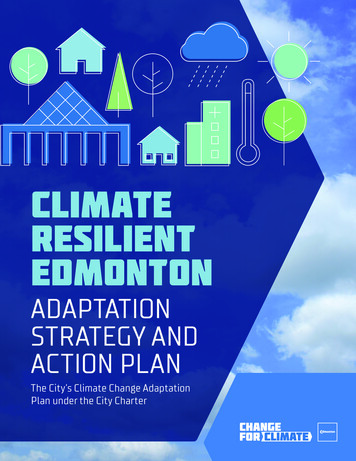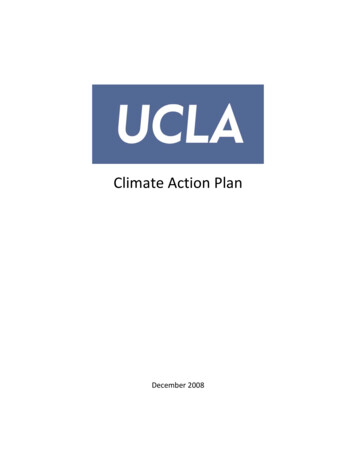
Transcription
Climate Action PlanDecember 2008
AcknowledgementsPrimary Authors:Tracy Dudman, Senior Planner, Capital ProgramsRenee Fortier, Director, TransportationDavid Johnson, Director, Energy Services and UtilitiesDavid Karwaski, Planning and Policy Manager, TransportationNurit Katz, Sustainability CoordinatorTova Lelah, Assistant Director, Capital ProgramsJ. Cully Nordby, Chair, Campus Sustainability CommitteeJack Powazek, Associate Vice Chancellor, General ServicesRobert Striff, Energy Manager, Energy Services and UtilitiesOther Contributors:Peter Angelis, Assistant Vice Chancellor, Housing & Hospitality ServicesRobert Gilbert, Sustainability Coordinator, Housing & Hospitality ServicesBill Propst, Director, PurchasingMichael Swords, Director of Strategic Initiatives, Office of the Vice Chancellor for ResearchPaul Bunje, Executive Director, Center for Climate SolutionsReviewed by the Campus Sustainability Committee:Chair: J. Cully Nordby, Academic Director, Institute of the EnvironmentStudents:Alisa Ahmadian, Undergraduate studentMichelle Hashemi, Graduate studentJuan Matute, Graduate studentKim Sanders, Undergraduate studentFaculty:Richard Ambrose, Director, Environmental Science & EngineeringFrancesco Chiappelli, Professor, Division of Oral Biology & MedicineCarl Maida, Adjunct Professor, School of DentistryThomas B. Smith, Acting Director, Institute of the EnvironmentBlair Van Valkenburgh, Professor, Ecology & Evolutionary BiologyStaff:Peter Angelis, Assistant Vice Chancellor, Housing & Hospitality ServicesApril De Stefano, Assistant Director, Center for the Study of WomenRobert Gilbert, Sustainability Coordinator, Housing & Hospitality ServicesNurit Katz, Sustainability CoordinatorTova Lelah, Assistant Director, Campus and Environmental PlanningLawrence Lokman, Assistant Vice Chancellor, University CommunicationsAntoinette Mongelli, Assistant ChancellorJack Powazek, Associate Vice Chancellor, General ServicesBill Propst, Director, PurchasingSue Santon, Associate Vice Chancellor, Capital ProgramsMichael Stone, Executive Director, Marketing & Communication ServicesPam Viele, Interim Executive Director, Student DevelopmentRobert Williams, Executive Director, ASUCLACommittee Staff: Andrew Bray, Graduate Student Researcher
UNIVERSITY OF CALIFORNIA, LOS ANGELESELESBERKELEY· DAVIS · IRVINE · LOS ANGELES · MERCED · RIVERSIDE · SAN DIEGO · SAN FRANCISCOUCLASANTA BARBARA·SANTA CRUZOFFICE OF THE CHANCELLORBOX 951405LOS ANGELES, CALIFORNIA 90095-1405December 18, 2008Dear Friends of UCLA:Thank you for your interest in sustainability at UCLA. This Climate Action Plan is a major stepin UCLA’s commitment to addressing global climate change and sustainability. The plandescribes how UCLA will meet the University of California’s policy targets of reducinggreenhouse gas emissions to 2000 levels by 2014 and 1990 levels by 2020. Through earlyactions in energy efficiency and transportation, UCLA has added more than 30 percent tocampus building square footage without significantly increasing greenhouse gas emissions. Thisstrong foundation of energy conservation will enable us to set a more aggressive goal and meetboth targets by 2012.This plan also outlines how UCLA will reduce its emissions through stationary and mobilesource emissions reductions initiatives, such as lighting and heating, ventilating and airconditioning (HVAC) retrofits and commute reduction strategies, and it also highlights some ofour academic and research initiatives. As an institution of higher education, our contribution tosolving the global climate crisis goes beyond addressing our own operations. We are educatingstudents to become leaders in sustainability and in conducting cutting-edge research in cleantechnology.The past initiatives highlighted in this plan represent years of hard work by staff, faculty, andstudents across the campus’ diverse disciplines and departments. Accomplishing the identifiedgoals and projects in the next decade will require the participation of the entire universitycommunity. All of us have a part to play in addressing global climate change and creating asustainable future for our children and grandchildren.I encourage you to visithttp://www.sustain.ucla.edu/ and find out how you can get involved.Sincerely,Gene D. BlockChancellor
TABLE OF CONTENTS11234567EXECUTIVE SUMMARY . 6INTRODUCTION . 11BACKGROUND ‐ GLOBAL CLIMATE CHANGE . 122.1International and Federal Policy . 122.2State of California Climate Change Policy (Assembly Bill 32) . 122.3Kyoto Protocol Greenhouse Gases ‐ CO2, CH4, N20, HFCs, PFCs, SF6 . 13GREENHOUSE GAS EMISSION INVENTORY 2007 EMISSIONS BY SOURCE . 143.1Stationary Emission Sources . 143.1.1Purchased Electricity . 143.1.2Purchased Natural and Landfill Gas & Cogeneration Plant Operations . 153.1.3Emergency Generators & Propane . 163.2Mobile Emission Sources . 173.2.1UCLA Fleet Vehicles. 173.2.2Commutes . 173.2.2.1Westwood Campus . 173.2.2.2Santa Monica/UCLA Medical Center . 193.2.3Air Travel . 191990, 2000 & 2007 EMISSIONS BASELINE . 204.1Baseline Emissions – All Stationary & Mobile Sources . 204.2Baseline Emissions – Stationary Sources . 204.3Baseline Emissions – Mobile Sources . 214.4Stationary Source Emissions – Past Progress . 214.5Mobile Source Emissions – Past Progress. 25EMISSION TRENDS – STATIONARY AND MOBILE SOURCES . 275.1Current Stationary Emission Trend – “Business as Usual” . 275.2Current Mobile Emission Trends – “Business as Usual” . 285.2.1Fleet Emission Trends ‐ “Business as Usual” . 295.2.2Commute & Airline Travel Emission Trends ‐ “Business as Usual” . 295.3Overall Campus Emission Trend – “Business as Usual” . 29EMISSION REDUCTION INITIATIVES . 31STATIONARY SOURCE REDUCTION INITIATIVES‐ CURRENT & PLANNED. 337.1Building Ventilation System Energy Conservation ‐ Phase I . 337.2Building Ventilation System Energy Conservation ‐ Phase II . 337.3On‐Campus Housing Energy Projects . 337.4Lighting Efficiency . 347.5Green Power Purchases . 347.6Solar Power Production . 357.7Cumulative Stationary Source Emissions Reductions. 367.8Future Energy Initiatives . 377.8.1Fume Hood Occupancy Sensors . 377.8.2Appliance Replacement Incentive Program. 377.8.3Dedicated Server Room Consolidations. 377.8.4Policy Changes. 377.8.5Encourage LADWP’s Green Energy Portfolio . 38
8MOBILE SOURCE EMISSION REDUCTION INITIATIVES – CURRENT & POTENTIAL . 398.1Fleet Emissions Reduction Initiatives . 398.2Commute Emissions Reduction Initiatives . 408.3Air Travel Emission Reduction Initiatives . 428.4Cumulative Mobile Source Emission Reductions . 439FINANCIAL FEASIBILITY‐ STATIONARY & MOBILE SOURCE INITIATIVES . 449.1Stationary Source Emission Initiatives – Financial Assessment. 449.2Mobile Source Emission Initiatives – Financial Assessment . 469.3Existing Funding for Other Sustainability Initiatives . 479.3.1UCLA’s Green Initiative Fund . 479.3.2Office for the Vice Chancellor of Research – Strategic Initiatives Group . 479.3.3University of California Systemwide Funding Opportunities . 479.4Potential Funding for Sustainability Initiatives . 479.4.1Airline Travel Carbon Offset Fund . 479.4.2Model Loan‐Based Funds – Harvard University & University of Michigan . 4810 BEHAVIORAL CHANGE INITATIVES‐ CURRENT & PLANNED . 4910.1Lab Energy Efficiency Program (LEEP). 4910.2Housing and Residential Life Inititatives . 5010.3Associated Students UCLA (ASUCLA) Initiatives . 5210.4Expanding Behavioral Change Education Initiatives . 5311 INSTITUTIONAL CHANGE . 5511.1Campus Sustainability Committee . 5511.2Sustainability Coordinator . 5511.3Green Building Design. 5511.4Environmentally Preferable Purchasing . 5711.5On‐Campus Housing and Dining . 5812 ACADEMIC PROGRAMS & SUSTAINABILITY RESEARCH . 6012.1Existing Courses and Academic Programs . 6012.1.1 Undergraduate Programs . 6012.1.2 Graduate and Professional Programs . 6212.1.3 Student Groups and Organizations . 6312.1.4 UCLA Staff Programs . 6412.1.5 Educational Events . 6412.1.6 Student Representation . 6412.1.7 Campus Interest . 6412.1.8 Expanding Academics: New Initiatives . 6612.2Research. 6712.2.1 Research Centers and Groups . 6812.2.1.1 Natural & Physical Sciences. 6812.2.1.2 Technology . 6912.2.1.3 Policy & Law . 7012.2.1.4 Human Health and Environmental Justice . 7212.2.2 Expanding Research: New Initiatives . 7313 COMMUNITY OUTREACH AND OTHER EFFORTS . 7413.1UCLA Extension . 7413.2Educational Events . 74
13.3City of Los Angeles and Los Angeles County Engagement. 7613.4Internships . 7613.5Mentorship . 7613.6Alumni . 7713.7Campus Sustainability Tour . 7713.8Community Engagement . 7713.9Communications Initiatives . 7814 CLIMATE NEUTRALITY POTENTIAL . 8115 CONCLUSIONS AND CLIMATE ACTION PLAN UPDATES . 8316 APPENDICES. 8417 BIBLIOGRAPHY . 93LIST OF FIGURESFigure 1‐1 UCLA Overall Emissions – 1990, 2000, 2007. 7Figure 1‐2“Business as Usual” vs. Potential Emission Reduction Initiatives . 9Figure 3‐1 Overall UCLA GHG Emissions, 2007 . 14Figure 3‐2 UCLA Employees’ Distance from Residence to Campus . 18Figure 4‐1 UCLA Overall Emissions – 1990, 2000, 2007. 20Figure 4‐2 Energy Use Per Square Foot 2000 to 2007 . 25Figure 5‐1“Business as Usual” ‐ Overall Campus Emissions Trend . 30Figure 6‐1“Business as Usual” vs. Potential Emission Reduction Initiatives . 32Figure 12‐1 UCLA Anderson Net Impact Paid Membership by Year. 65Figure 12‐2 Enrollment in Environmental Science Major . 66LIST OF TABLESTable 3‐1 CO2 Emissions from Purchased Electricity ‐ Baseline Years . 15Table 3‐2 CO2 Emissions from Purchased Natural Gas ‐ Baseline Years . 16Table 3‐3 CO2 Emissions from Purchased Diesel Generator Fuel ‐ Baseline Years . 16Table 3‐4 CO2 Emissions from Purchased Propane ‐ Baseline Years. 16Table 3‐5 Quantifying Air Travel GHG Emissions, 2007 . 19Table 4‐1 UCLA Growth in Square Footage – 1990, 2000, & 2007 . 21Table 4‐2 Mobile Source Emissions – 1990, 2000, & 2007 . 21Table 5‐1 Stationary Source Emissions, “Business as Usual”. 28Table 5‐2 Cumulative Mobile Source Emissions, “Business as Usual”. 28Table 7‐1 Stationary Source Initiative Cost Effectiveness. 35Table 7‐2 Stationary Initiatives Annual CO2 Reduction . 36Table 8‐1 Fleet GHG Emissions Reduction Initiatives . 39Table 8‐2 Commute GHG Emissions Reduction Initiatives . 42Table 8‐3 Airline Travel GHG Emissions Reduction Initiatives . 43Table 9‐1 Stationary Source Initiative Payback Periods. 44Table 9‐2 Mobile Source Initiative Emission Reduction and Cost per Metric Ton of CO2 . 46Table 11‐1 UCLA Green Building Initiatives . 56Table 13‐12008‐2009 Sustainability Communications initiatives. 80
Climate Action Plan1EXECUTIVE SUMMARYBackgroundIn 2007, in response to growing concern over the impacts of climate change, theUniversity of California Office of the President developed a climate protection section ofthe UC Sustainable Practices Policy. The UC Policy set three climate change goals for theten UC campuses: Reduction in campus emissions to year 2000 levels by 2014; Reduction in campus emissions to year 1990 levels by 2020; and Attainment of climate neutrality as soon as possible.These goals are in parallel with the California Global Warming Solutions Act of 2006(Assembly Bill 32) and based on the American College and University Presidents ClimateCommitment, which the UC President and the UC Council of Chancellor’s signed, joininguniversity leaders across the country. The UC policy also calls for UC campuses to draft aClimate Action Plan (CAP) that examines the feasibility of meeting these goals. Thisdocument is the Climate Action Plan for the University of California, Los Angeles (UCLA).UCLA has a decades‐long history of pursuing sustainable practices in campuswideoperations and has established extensive academic, research, and community outreachprograms in climate change and sustainability. By building upon past achievements, thisClimate Action Plan (CAP) outlines a comprehensive range of initiatives to advancecampus sustainable practices and further reduce UCLA’s carbon footprint. The UCLA CAPaddresses carbon emission reduction initiatives including behavioral change, energy useand conservation, student and workforce commutes, and air travel. The CAP alsoexamines the feasibility of these initiatives and determines a target for UCLAgreenhouse gas (GHG) emissions reductions. Every initiative that is implemented movesthe campus closer to achieving the ultimate goal of climate neutrality.UCLA GHG Emissions InventoryThis CAP analyzes UCLA’s GHG emissions according to guidelines for universities setforth by the California Climate Action Registry that address emissions from stationary aswell as mobile sources including commutes. The year 2007 is used as a baseline in theanalysis, and the CAP examines emissions in the target years of 1990 and 2000.Well before 1990, energy efficiency and traffic reduction initiatives were pursued byUCLA primarily to reduce energy costs and limit the campus contribution to local andregional traffic and air quality pollution. During the 1990s the campus built a highlyefficient Cogeneration Plant that resulted in significant increases in energy efficiency. Asa result of this and other energy and transportation initiatives, UCLA’s GHG emissions in2000 were lower than in 1990 and the emissions in 2007 were only marginally higherPage 6
Climate Action Planthan in 1990, despite a 34 percent growth in campus square footage and an increase instudent and workforce population between 1990 and 2007. See Figure 1‐1.Figure 1‐1UCLA Overall Emissions – 1990, 2000, 2007338,449350,000338,730312,000CO2 Emissions (metric tons)Energy300,000Air ,46336,8584,5698,0325,2770199020002007UCLA GHG Emissions Trend, Business as UsualFor purposes of evaluating the effectiveness of GHG emission reduction potential fromplanned or future initiatives and programs, UCLA established a “Business as Usual”(BAU) scenario beginning in 2007 and extending to 2020. The intent of establishing theBAU is to illustrate the future emissions of the campus assuming that no additional GHGreduction initiatives are implemented. The model incorporates growth projections forstationary sources, based in part on assumed increases in gross square footage, andgrowth projections for mobile sources based on estimated campus population growth.Utilizing all of the assumptions and calculations for projected emissions for stationaryand mobile sources, the BAU scenario projects a rise to approximately 369,946 annualmetric tons of CO2 by 2020; an increase of 31,216 metric tons of CO2 above the 2007emissions of 338,730 metric tons of CO2.As a premier institution of higher education, research, and community service, UCLA willcontinue to advance, and must plan for, additional housing, education, and researchfacilities. While the campus has a Green Building Program that targets achievement of aPage 7
Climate Action Planminimum USGBC LEED 1 Silver rating for all new construction and major renovation,increased energy needs to power and air condition new facilities is inevitable, which willresult in increases in GHG emissions. Student and workforce population is anticipatedto increase and mobile emissions will also increase if transportation initiatives are notpursued.UCLA Reduction InitiativesThis CAP considers initiatives that focus on reductions in GHG emissions from stationarysource energy use (i.e. Cogeneration Plant and purchased utilities) and emissions frommobile sources (campus fleet vehicles, commutes, and air travel).The GHG reductioninitiatives described in this CAP fall into three main categories: energy use reduction and efficiency; mobility – reduction in vehicle miles traveled and utilization of alternativetransportation modes; and behavioral changes aimed at influencing individual and institutional choicesrelated to energy use and mobility.Energy initiatives include building system upgrades that improve efficiency of heatingand cooling equipment, installation of more energy efficient lighting systems, andinclusion of “green” power and solar energy in the campus’ energy portfolio. Improvingthe energy efficiency of existing buildings and pursuing alternative energy sources willresult in a significant reduction in the GHG emissions of the campus.Transportation initiatives will increase the number of clean and alternative fuel fleetvehicles, reduce single‐occupant commutes to campus, and possibly establish anemissions mitigation fund for air travel, all of which would contribute to a substantialemission reduction potential.This CAP also recognizes that behavior change is at the core of many of UCLA’s proposedinitiatives to reduce GHG emissions. Behavioral change toward more sustainablepractices, though difficult to quantify in terms of emissions reduction, is inherent in allGHG emission reduction initiatives. Provision of sustainability education awareness incampus operations continues to positively influence areas such as recycling, purchasing,housing, dining, as well as energy and water conservation. With engagement andsupport from the Campus Sustainability Committee and a full‐time campus sustainabilitycoordinator, a “culture of sustainability” is emerging campuswide.In addition to these initiatives, academic and research initiatives addressed in this CAPwill have an enduring benefit by creating new technologies and training students tobecome leaders in addressing challenges of global climate change for years to come.1United States Green Building Council (USGBC) has developed Leadership in Energy and EnvironmentalDesign (LEED)Green Building Program , which includes four levels: Certified, Silver, Gold, and Platinum.Page 8
Climate Action PlanUCLA Emissions Reduction TargetBased on analysis of the impact of the proposed initiatives, UCLA determined that it ispossible to set more aggressive targets for GHG reduction than those outlined in the UCPolicy. As a result of early actions and through implementation of the proposed GHGreduction initiatives analyzed in this CAP, it is anticipated that UCLA will be able toreduce campus GHG emissions below 1990 and 2000 levels by 2012 without use ofpurchased energy offsets or credits. See Figure 1‐2 below.Figure 1‐2“Business as Usual” vs. Potential Emission Reduction InitiativesThe ability of the campus to set this target is a reflection of the effectiveness of past andexisting campus sustainability programs, as well as the far‐reaching initiatives proposedin this CAP. Reaching the climate neutrality goal however, will require a paradigm shiftin energy production technology and individual behavior – a significant challenge for anenergy intensive campus such as UCLA. UCLA can play an important leadership role insupporting and advancing research and educational efforts to accelerate behavioralchange and bring new energy technologies to the global marketplace.Page 9
Climate Action PlanMoving ForwardThis CAP reflects the first comprehensive examination of the campus’ sustainability andGHG emission reduction programs and represents a major step towards advancingUCLA’s leadership role as an academic institution in the area of sustainability and as avanguard of global responsibility. The CAP will provide a foundation for assessingsustainability on campus. UCLA will track progress of these initiatives on an annual basisand will publish updates to the plan every two years. It is anticipated that updates ofthis CAP will enable consideration of emerging technologies that will propel the campuscloser to achieving the ultimate goal of climate neutrality.With this CAP, UCLA is embracing its responsibility to be a leader in addressing climatechange and sustainability. UCLA is not only demonstrating that this can be done in afinancially feasible way, but also plans to reach out to and educate the community thatit is every person’s civic responsibility to participate in activities and behaviors to reduceGHG emissions. UCLA will also take steps to integrate the initiatives outlined in this CAPinto the academic and research mission by expanding academic programming andsupporting faculty research that stimulates new technologies and student involvementin finding solutions to the global warming challenge. One innovative research initiativewill be to pursue the viability of “off setting” UCLA’s GHG emissions (towards reachingclimate neutrality) by reinvesting in its world‐class faculty and students for the specificpurpose of researching and developing new technologies to minimize environmentaleffects of worldwide population growth and economic development.Page 10
Climate Action Plan1INTRODUCTIONOn March 22, 2007, University of California (UC) President Robert C. Dynes, signed theUniversity of California Policy on Sustainable Practices (UC Policy), which committed theten UC campuses to minimize their individual impacts on the environment and chargedthem to reduce their dependence on non‐renewable energy. The UC Policy includesclimate change practices with overall goals to develop a long‐term strategy to reduceGHG emission to 2000 levels by 2014, 1990 levels by 2020, and achieve climateneutrality as soon as possible while maintaining the University’s overall academic andresearch mission.The UC Policy was developed in conjunction with the American College & UniversityPresidents Climate Commitment (ACUPCC), a high‐visibility effort to address globalwarming through institutional commitments to reduce and ultimately neutralize GHGemissions while accelerating the research and educational efforts of higher education tore‐stabilize the Earth’s climate. 2 The University of California is a signatory to theACUPCC, thus all ten campuses are required to comply with implementation periods,institutional structures, GHG emission inventory protocols, and guidelines fordeveloping climate action plans as developed by the ACUPCC.Pursuant to the Policy, UCLA has become a member of the California Climate ActionRegistry (CCAR) and developed this Climate Action Plan that incorporates protocols toallow for growth adjustment and normalization of GHG data and reporting mechanismsto monitor progress towards the emission reduction goals.
Thank you for your interest in sustainability at UCLA. This Climate Action Plan is a major step in UCLA's commitment to addressing global climate change and sustainability. The plan describes how UCLA will meet the University of California's policy targets of reducing greenhouse gas emissions to 2000 levels by 2014 and 1990 levels by 2020.

